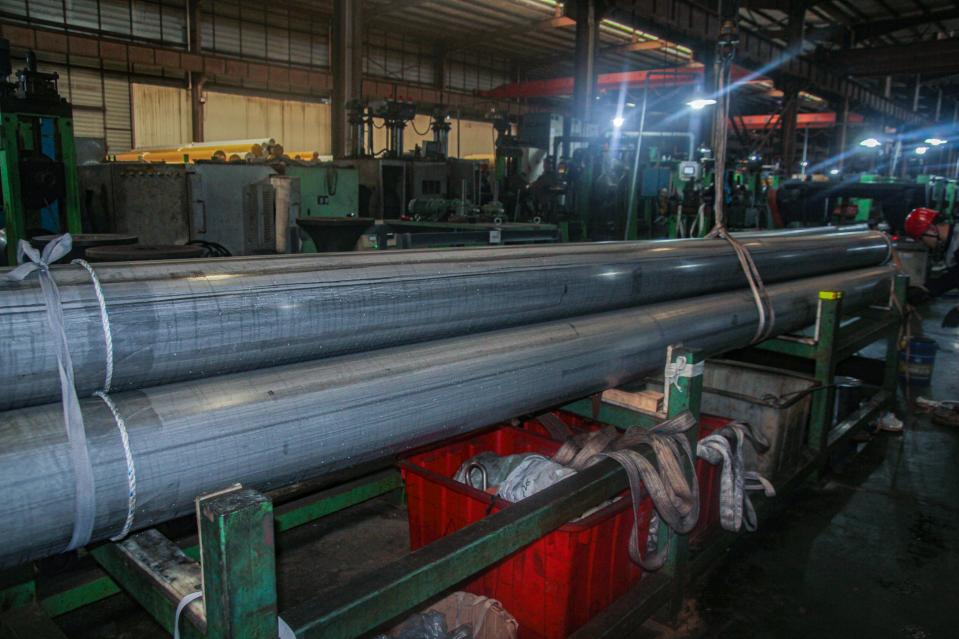Nondestructive Testing Standards for Seamless Stainless Steel Pipes
In the stainless steel industry, seamless stainless steel pipe inspection is a critical quality control process that ensures structural integrity, safety, and corrosion resistance. International and national standards have established a comprehensive framework of nondestructive testing (NDT) methods for evaluating defects in seamless pipes — including ultrasonic testing (UT), eddy current testing (ET), and magnetic particle testing (MT).
As a leading manufacturer of seamless stainless steel pipes, Ganyeah Group strictly follows international, Chinese, and American standards to guarantee reliable products for industries such as oil and gas, LNG, petrochemical, and aerospace.

DNV stainless steel pipes for offshore platforms
1. International Standards (ISO/EN)
Ultrasonic Testing (UT)
- ISO 10893-11:2020
Defines automated transverse wave ultrasonic testing for welded and seamless steel pipes, including longitudinal and transverse defect detection. The standard specifies four acceptance levels (U2–U5) with defect depth limits between 5–15% of wall thickness and now supports phased array (PAUT) techniques. - EN ISO 17635:2025
General rules for nondestructive testing of metallic welds, newly updated to include total focusing method (TFM) and phased array UT, improving accuracy for thin-wall stainless steel pipes.
Eddy Current Testing (ET)
- ISO 10893-2:2011
Covers automated eddy current testing of seamless and welded steel pipes, detecting surface and near-surface flaws using calibrated sensitivity reference blocks.
Magnetic Particle Testing (MT)
- ISO 9934-1:2016
General principles for magnetic particle inspection of ferromagnetic materials. Austenitic stainless steels, such as 304 and 316L, are excluded due to their non-magnetic nature.
2. Chinese National Standards (GB/T)
Ultrasonic Testing
- GB/T 5777-2008
Specifies pulse-echo ultrasonic testing for seamless steel pipes with outer diameters of 6–76 mm. It defines methods for detecting internal longitudinal defects such as cracks and inclusions. - GB/T XXXX-XXXX (Draft)
Under development for end-section ultrasonic inspection using phased array technology, targeting delamination and transverse defects near pipe ends.
Eddy Current Testing
- GB/T 7735-2016
Equivalent to ISO 10893-2:2011, it regulates frequency ranges (1–15 MHz) and acceptance grades (A, B, C) for detecting surface flaws deeper than 0.1 mm.
Magnetic Particle Testing
- GB/T 15822.1-2024
Latest revision emphasizes environmental safety of magnetic suspensions and defines procedures for detecting surface cracks in ferritic stainless steels (e.g., 410, 430) using wet fluorescent methods.
3. American Standards (ASTM / ASME)
Ultrasonic Testing
- ASTM A388/A388M-11
Applicable to stainless steel forgings and seamless pipe billets, requiring defect signals ≥50% of the reference amplitude from a 3 mm flat-bottom hole. - ASME BPVC Section VIII-2
Pressure vessel standard mandating 100% ultrasonic inspection for stainless steel pipes with wall thickness ≥16 mm.
Eddy Current Testing
- ASTM E243-24
Provides guidance on coil configuration and signal analysis for tubular materials, useful for adapting eddy current testing of stainless steel pipes.
Magnetic Particle Testing
- ASTM E709-24
Specifies fluorescent magnetic particle inspection for ferromagnetic stainless steels, requiring certified inspectors per ASNT SNT-TC-1A.
4. Industry Standards (API / AMS)
Oil & Gas Pipelines (API 5L-44)
For pipeline-grade seamless stainless steel pipes, PSL2 level requires 100% UT and ET coverage. Ultrasonic testing identifies internal flaws, while eddy current testing detects surface cracks ≥0.5 mm deep.
Aerospace Applications (AMS 2631)
Defines ultrasonic and eddy current methods for titanium and stainless steel tubes using focused probes and multi-frequency systems to identify internal porosity and metallurgical inconsistencies.
5. Key Parameter Comparison Table
| Standard Category | International (ISO/EN) | China (GB/T) | United States (ASTM/ASME) | Industry (API/AMS) |
|---|---|---|---|---|
| UT (Ultrasonic Testing) | ISO 10893-11:2020, EN ISO 17635:2025 | GB/T 5777-2008 | ASTM A388-11, ASME BPVC VIII-2 | API 5L-44, AMS 2631 |
| ET (Eddy Current Testing) | ISO 10893-2:2011 | GB/T 7735-2016 | ASTM E243-24 | API 5L-44 |
| MT (Magnetic Particle Testing) | ISO 9934-1:2016 | GB/T 15822.1-2024 | ASTM E709-24 | ASME BPVC VIII-2 |
6. Recommended Testing Combinations
- High-pressure pipeline systems: Combine GB/T 5777 (UT) and API 5L-44 (ET) to ensure internal and surface defect coverage.
- Pressure vessel welds: Use ASME BPVC VIII-2 (UT-PA) for internal defect detection and GB/T 15822.1-2024 (MT) for surface flaws.
- Thin-wall medical stainless pipes: Apply ISO 10893-2 (ET) for 100% online inspection of micro-defects (≥0.2 mm).
- Ferritic stainless components (e.g., valves): Use ASTM E709-24 (MT) under UV lighting for precise surface crack detection.
7. Latest Developments and Emerging Trends
- ISO 17635:2025 introduces Total Focusing Method (TFM) for 3D imaging of defects in complex pipe geometries.
- GB/T 5777-2024 (Draft) incorporates Electromagnetic Acoustic Transducer (EMAT) technology for high-temperature pipes up to 500°C.
- ASTM E243-24 adds AI-driven signal recognition, allowing automatic identification of cracks and pits through machine learning.
The nondestructive testing of seamless stainless steel pipes is governed by a rigorous global standard system. Whether for offshore energy, LNG transport, or aerospace engineering, compliance with ISO, ASTM, and GB/T standards ensures the highest reliability and safety.
At Ganyeah Group, we integrate these NDT standards into our production and quality management systems, offering customers seamless pipes that meet the most demanding corrosion resistance, pressure tolerance, and surface integrity requirements.
